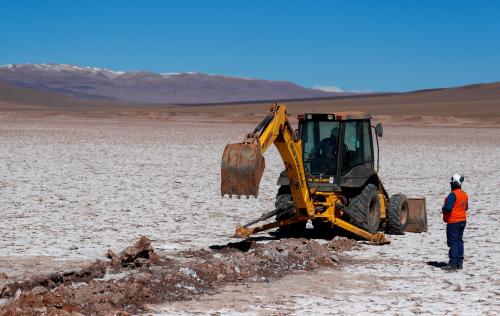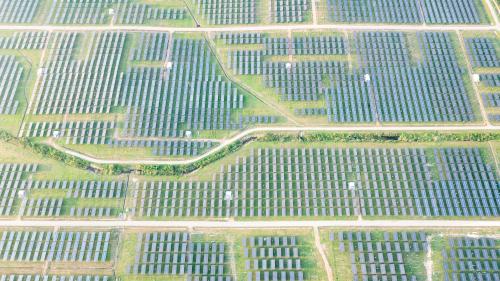Content from the Brookings Institution India Center is now archived. After seven years of an impactful partnership, as of September 11, 2020, Brookings India is now the Centre for Social and Economic Progress, an independent public policy institution based in India.
This article first appeared in Infraline Plus Magazine March 2019 issue. The views are of the author(s).
Whether full household electrification is achieved by March 2019 or later, India’s efforts at electrifying its rural population since the turn of the millennium have received universal recognition. However, several observers have noted that the presence of requisite infrastructure in a village to officially deem it ‘electrified’, or even wire to households as taken up under Saubhagya scheme, are just steps towards electrification than ends unto themselves. In 2014, as a part of SAARC delegation to offer the perspective of global south on the draft sustainable development goals (SDGs), this author proposed the rationale for and means to ensure that ‘sustainability of access’ be built into the goal of universal access. This article elaborates on that idea in light of the emerging Indian context.
Defining Sustainability of Access
Energy access is critically linked to development outcomes in health, education, livelihoods, disaster resilience, and gender equality in the developing world. Energy and income poverty are highly correlated with other vulnerability indices as with each other. Due to this, any shocks or stresses in the electricity system threaten to deprive the access of the most vulnerable—case in point being the 2012 blackout in North India that disproportionately impacted the subsidised groups.
Acknowledging such aspects, the UN Sustainable Energy for All (SEforALL) proposed a multi-tiered framework to measure access across various attributes such as peak availability, duration, evening supply, affordability, legality and quality. Each tier is associated with improved outcomes on these attributes. In conjunction with this, tiers of electricity use are employed to ascertain the growth in more sophisticated and productive uses beyond charging, lighting, and fans. This could include things such as electric cookers and sowing machines.
On a temporal scale, not only should such outcomes improve, but so should the means to ensure these outcomes, or in other words, enabling conditions. From the supply side, this implies ensuring the long-term sustainability of the electricity system in a situation where the poorest and most vulnerable consumers are reflexively pushed out when the system experiences strain. On the demand side, the most important challenges to effective utilisation of electricity in rural and lower-income households (discussed later) must also be addressed. Together, an improvement in both outcomes and enabling conditions define Sustainability of access.
Where We Stand
At first glance, the effort required to implement such a proposal appears monumental from where we stand. Not only are the utilities mandated with 24×7 supply (including rural), but also to bring their losses to a common minimum of 15 percent. This is despite the fact that technical and economic losses in rural distribution are significantly higher compared to urban and/or high-tension consumers, some due to unavoidable reasons. Saddled with operational concerns, the top-down targets for utilities (at times, conflicting) and state-centre tussles render outcomes ineffective and leave the utilities in a survival fight. Strategic aspects of long-term planning are compromised when such imminent issues take up decision-makers’ mind-space.
The mother of all challenges in rural access is low electricity demand leading to low utilisation of electricity infrastructure and therefore high costs per unit of supply.
Rural supply also suffers from diseconomies of scale. The infrastructure has to be drawn over much larger distances compared to urban areas and industrial clusters. The greater risk of theft is compounded by low prevalence end-use metering. The latter is particularly true for often state-subsidised groundwater irrigation, which is also the largest consumption category in rural supply. For decentralised renewable energy (DRE) based mini-grids, micro-grids or even household-based solutions, the costs to serve are far greater than the average grid costs.
Household-level electricity consumption also is much lower for rural consumers—this author’s recent study at Brookings shows that electricity demand by 2030 (with escalating consumption) for the roughly 70 million households currently without access to dwelling units will be around 5 percent of today’s consumption. The net result is that rural households end up consuming less than a fifth of electricity on average, sometimes at over ten times the effective price paid by their urban counterparts.
Private sector does not have a similar capacity as public enterprises in enduring the risks and potential losses inherently involved in supplying to rural customers, risking the long-term sustainability of access.
Therefore, the mother of all challenges in rural access is low electricity demand leading to low utilisation of electricity infrastructure and therefore high costs per unit of supply, in addition to fundamentally higher costs of connecting geographically dispersed households. This hampers scalability, and there can be no universal access without scalability.
Many commentators have proposed DRE as a solution to this problem. But DRE fundamentally remains a private sector concern, implying that it will come up opportunistically in places where the business case is clear. The private sector does not have a similar capacity as public enterprises in enduring the risks and potential losses inherently involved in supplying to rural customers, risking the long-term sustainability of access. These risks are significantly higher at lower tiers of electricity use. Therefore, an escalation of ambition is required to overcome these risks by breaking out of the low consumption trap facing the recently and future electrified units.
Some Next Steps Towards Ensuring Sustainable Access
Sustainable electricity access is critically linked to positive developmental outcomes. Given multiple positive externalities and long pay-back periods associated with universal electricity access, the dividends it yields cannot be fully internalised. In other words, it’s like spending on fundamental aspects of the economy such as R&D, only more urgent since it comprises a crucial goal of human development. Therefore, it assumes a social mandate, which the government has committed to.
The uncertainty of hours and quality of grid supply results in rural enterprises using diesel generator-sets (again, often as primary source of electricity).
With this perspective, some steps generating positive outcomes and enabling conditions for sustainability of electricity access are discussed below:
- Stimulate demand: The key to unlocking rural electricity demand is by emphasis on economic units in the service and industrial sectors that value stable and continuous electricity supply. This expands the base of rural demand and reduces the cost to serve for households. Successful examples of private franchisee models have been accompanied by interventions elsewhere, such as cooperatives, local industry that harbours specialised skills, and small-scale financing schemes.
The primary driver for future household consumption will be augmentation of incomes through diversification of rural livelihoods into secondary and tertiary activities. This is a long-term process, and electricity is an enabler for productive uses, which in turn stimulates electricity demand via multiplier-effect. With merely a household level focus, there is a risk that overall consumption will remain low, and costs to serve high.
- Provide options: Multiplicity of fuel options is a reality of life in the rural sector. Surveys show that second-time users of LPG under UJJWALA scheme are much lower than number enrolled owing to high costs and difficulty in procurement, so they continue to use biomass as the primary fuel. The uncertainty of hours and quality of grid supply results in rural enterprises using diesel generator-sets (again, often as primary source of electricity). Therefore, in the present expansionary stage of electricity provision, both DRE and the grid have a role to play to shift consumption from traditional fuels.
Even if the grid expands to areas hitherto serviced by DRE, it will increase the competition to provide better service at reduced costs, pushing away the reliance on diesel generator sets. We are witnessing this in the irrigation sector, where pump-set electrification and different models of solar pumping have considerably brought down diesel use. Grid and DRE supply have different mandates, models and frameworks for electricity provision, each associated with its strengths and weaknesses. There is ample room for them to play complementary roles.
In a similar way, a complementary effort at electrifying cooking aside from LPG provision can potentially enhance electricity consumption and reduce dependence on biomass. Unlike LPG provision that suffers from logistical bottlenecks in rural areas, electricity is available on demand and costs and emissions per unit of delivered energy are also lower.
- Generate Trust: A number of studies have shown willingness to pay among marginal consumers for quality service. But owing to the issues discussed previously, the uptake of and reliance on modern fuel options suffers from concerns about the service availability and quality, integrity in billing and transactions, perceived high-handedness of the officialdom, etc. Availability of infrastructure is only the first step towards generating trust. Despite resistance to metering in some agricultural areas that receive free supply, field surveys show that households that are metered and billed regularly also tend to pay on time.
Putting this mandate on utilities and distribution franchisees also requires support and allocation of adequate funds with the understanding that these costs will not be recoverable in the short-term, especially from the households. Over a larger base of consumption including enterprises, a limited cross-subsidy can be explored. Simply having poles, wires and connections without minimum service quality standards will likely result in meeting electrification objectives as defined on paper, but not meaningful access.
- Monitor Outcomes: As mentioned in the previous section, perhaps the hardest part of this is to be able to monitor the outcomes effectively. While the national sample surveys have played an important role in supplementing supply with demand side statistics, the monitoring envisaged under the UN SEforAll framework requires much higher sophistication and may not be possible without active stakeholder participation. This will not only help with improving feedback and accountability on both sides, but provide valuable inputs to policymakers on what is working and what is not. The training and engagement required to implement such a monitoring regime will also help in facilitating behavioural change towards adopting modern energy.
The role of information and communication technologies is critical – smart meters can not only help in early identification and rectification of common issues (as identified above) associated with rural supply but also increase the system’s resilience and reliability in the longer term. Together with this, human intervention is an important complementarity required for effective feedback loop and sustainable transformation.
Having reached a stage where full household electrification is within touching distance, the task on universal access to safe and affordable energy is just beginning. This signals a gradual shift in focus from provision of hard infrastructure to ecosystem level issues. The steps provided here are some of the several inter-related measures required to ensure that the efforts of the past reach fruition in meeting the ultimate goal. To this end, the state and central support to critical actors in the process should only increase. At the same time, the efforts to ensure that access is self-sustaining, that is, with the least possible subsidy support, should also continue.




Commentary
Op-edSome steps towards escalating the ambition on Universal Electricity Access
April 2, 2019